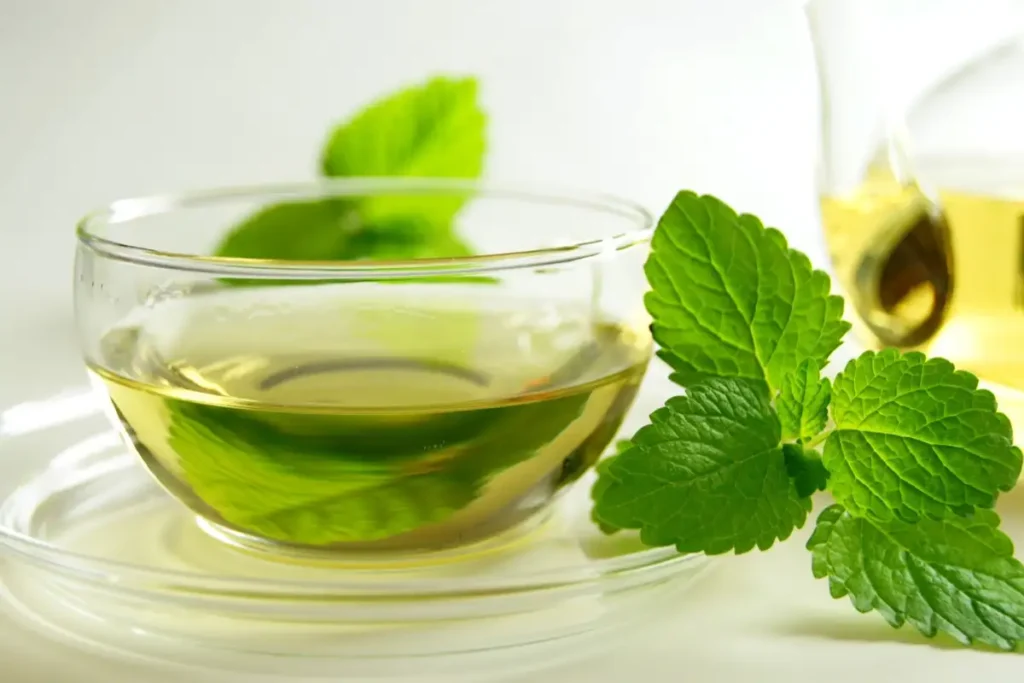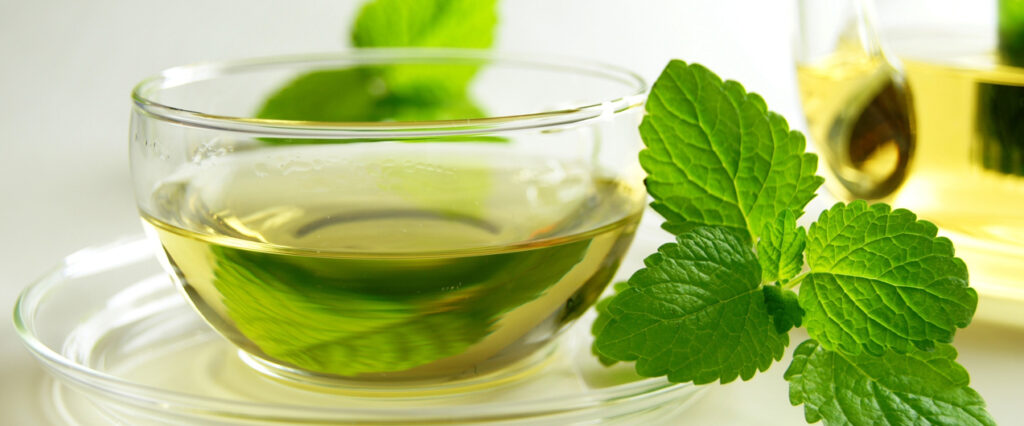A cup of mint tea before bed will help you relax, relieve muscle pain and relieve fatigue. In addition, mint tea at night helps to normalize blood pressure and strengthen the cardiovascular system. To make mint tea, pour a handful of mint leaves into hot water and let steep for 15 minutes – the tea is ready.
The benefits and harms of mint tea
The ancients learned about the unique healing properties of mint hundreds of years ago. And to this day, this plant is on everyone’s lips. You can’t confuse mint with anything. Such wild popularity came to her for a gentle, refreshing, tonic taste and unique aroma.
A cup of fresh mint will help you escape from stress, unobtrusively relax after a busy day and gently calm the nervous system. In the heat, it will bring the long-awaited coolness and warm in the harsh winter cold. But why is mint tea so useful? When should you refrain from it? What are its most popular cooking methods and most delicious recipes? A full review of mint tea at night is below.
Mint and its properties
Even before our era, mint was available to man. It is mentioned on the cuneiform tablets of the Assyrians, it was found in the tombs of the Egyptian pharaohs. Mint is even mentioned in the Gospel of Matthew. This plant is easily recognizable – it has branched stems and leaves, a bit reminiscent of nettles. Mint reaches a height of 80 cm. The menthol contained in them gives a special aroma to its leaves. It is he who provides the mint drink with a unique refreshing taste.
The chemical composition of mint
The first and perhaps the most important chemical in mint is menthol. This is an organic substance containing secondary alcohol. It is he who gives the mint leaves a specific smell. But menthol still has something to surprise. It has strong cooling properties: it stimulates cold receptors in the skin and mucous membranes, and can be used as an antiseptic and local anesthetic.
Mint very well reduces capillary permeability and improves blood circulation due to a substance such as rutin. With regular use of the herb, it helps to reduce the risk of blood clots.
The next chemical in mint is carotene. It is considered a natural immune stimulant, because it reduces the production of free radicals. It is especially beneficial for the elderly or those who are partly stressed. The high content of T-lymphocytes in food containing carotene accelerates the immune response to external stimuli.
Mint is also rich in beneficial acids. In particular – ascorbic and chlorogenic. The first increases the body’s resistance to viral infections, participates in the formation of collagen, improves iron absorption. The second acts as a strong antioxidant, reduces the risk of cardiovascular disease. The leaves, stems and flowers of mint also contain an essential oil with a high percentage of menthol, azulene and flavonoids.
What is mint
Along with all the well-known peppermint and lemon types of mint, there are still about a dozen variations of the plant. This grass is not alone, but has many brothers. Among them are chocolate, menthol, field, cat, water, fragrant, forest, Japanese, pepper, curly, Mexican, lemon, wild. And each of them has its own rules for planting, its own habitat and its own properties. But we are only interested in the two most famous types: peppermint and lemon mint.
Peppermint is familiar to everyone and everyone without exception. It is a perennial plant and can reach up to one meter in length. The leaves are green, the characteristic difference is the jagged edges. Peppermint easily tolerates winter and severe frosts. Do not forget that it is artificially bred and is a kind of water mint.
Lemon mint is commonly referred to as lemon balm. It can often be found in garden plots. This is a hardy perennial plant. In height, it can also reach up to 1 meter. A distinctive feature of this type of mint is the presence of a lemon aroma, especially during flowering. That’s why she was named accordingly.
The benefits and harms of mint
Stress, depression, neurosis – all these emotional and psychological disorders inevitably haunt modern man. But their destructive effect can be minimized, of course, not only by medication. Along with physical activity or the practice of meditation, mint tea can help a person. And yes, this is not an exaggeration. Of course, it is not a panacea for all problems, but you should not forget about the gigantic amount of useful properties of mint.
Useful properties of mint
You can talk about the beneficial properties of mint for a very long time. We will focus on ten main points.
• Mint tea at night has a pronounced sedative effect. He is able to gently relax after a working day, relieve tension and stress.
• It is difficult to overestimate the usefulness of mint tea in the treatment and prevention of colds. It can not only reduce the temperature, but also improve the general condition of a sick person.
• If you drink mint tea in conjunction with medications, it will help eliminate severe symptoms of acute respiratory diseases. Moreover – to improve the discharge of sputum from the lungs and relieve the runny nose.
• If the wife repeatedly says she has a headache, give her peppermint tea. It is considered to be a great help in relieving headaches in women. In addition, the drink is able to regulate the menstrual cycle.
• Among the merits of mint tea is the normalization of blood pressure. It also helps blood circulation, relieves heart conditions and helps with unbearable spasms during migraine attacks.
• If your agenda is to lose weight, mint tea will be a great helper in this matter. It is able to speed up the metabolism.
• A bandage containing mint tea can even bandage an irritated area of the skin. It has an antibacterial effect, so a freshly brewed infusion will soothe itching.
• Peppermint tea helps with problems with the gastrointestinal tract, in particular – reduces the acidity of the stomach, contributing to the normalization of its microflora.
• Peppermint tea has an anti-spasmodic effect. It not only helps to eliminate intestinal colic and balance the bile balance, but also reduces gas formation.
• Peppermint tea at night perfectly normalizes sleep, eliminates anxiety, and even improves brain activity.
Harm and contraindications of mint tea at night
The ten benefits we have highlighted seem impressive. They can impress to such an extent that mint tea will be perceived as a universal remedy for almost any infection. However, this drink has its known drawbacks. Let’s talk about them.
Firstly, mint tea at night is contraindicated in diabetes. Menthol may react with preparations containing insulin.
Secondly, mint often causes an allergic reaction in children. If, after using it, a rash develops on the skin, a headache begins, or breathing becomes difficult at all, you must immediately stop eating mint.
Thirdly, mint tea should not be drunk during pregnancy and breastfeeding. Although the testimony of doctors in this matter is ambiguous. However, it has been proven that menthol reduces the mother’s ability to produce milk.
Fourth, if you suffer from varicose veins or low blood pressure, mint should also be avoided. With a decrease in vascular tone, this herb can lead to an exacerbation of any other chronic disease. It is not recommended to abuse mint tea and people suffering from heartburn.
The use of mint in cooking, medicine and perfumery
Mint contains a fragrant oil called geraniol. It is one of the main constituent substances in perfumery, used to create perfumes and aromatize soaps, body cosmetics, and detergents.
In cooking, mint has also found its use. It is an aromatic seasoning for various dishes. Mint leaves are a great decoration for cakes and cocktails. In Germany, France and England, mint is widely used as a seasoning for vegetables. It is added to various spice mixtures to improve the aroma and taste of sauces and marinades.
Peppermint proved to be useful in medicine as well. An infusion of its leaves is taken in several cases: for vision problems, as a sedative, to reduce fever, for gastrointestinal diseases, and even as an aphrodisiac. As we have said, mint can also be used externally. For example, it does an excellent job as an analgesic for rheumatic pains in the joints, as well as for insect bites. Peppermint essential oil contains a lot of menthol, which has an analgesic, antiseptic effect, relieves stress, reduces weather sensitivity.

Methods for harvesting mint
There are three of the most time-tested ways to harvest mint for the winter. The first one is to dry it properly. The second is to expose to the freezing effect of cold and the third is to prepare mint syrup. Each method is original in its own way and allows mint to retain its beneficial properties.
Drying mint
Mint begins to bloom in June. At this time and until the end of July, they begin to collect it. High humidity can adversely affect the drying process, so picking mint bushes is best either in the morning or in the evening. In the first case, the rum will just have time to dry, and in the second, on the contrary, it will not yet have time to form.
First you need to remove dirty and damaged leaves from all raw materials. The rest should be washed and dried thoroughly with a paper towel. Drying itself can be done either in the fresh air, or in the oven or microwave. It all depends on how much time you have.
For drying in the fresh air, the stems are tied in bunches and hung upside down. To do this, you need to find a dark, dry place with good air circulation. Paradoxically, direct sun exposure during drying should be avoided. As soon as the leaves begin to easily come off the stems, drying stops.
Drying in an open oven is incomparably faster – only 15-20 minutes. The main thing is not to overdo it with the temperature, because at more than 75 degrees the leaves lose all their useful qualities. Dried mint keeps for about a year and a half. So that it does not lose its taste, it is necessary to use an airtight container made of glass, metal or plastic.
Freezing mint
The main property of freezing is to extend the shelf life of the product without significant loss of its qualities. Frozen mint perfectly retains its unique taste and aroma. For proper freezing it is necessary to use fresh leaves without damage and stains. You can freeze mint in several ways:
• Whole leaves. To begin, immerse the mint in cool water, and then let the towel soak up all the moisture. We put the resulting dry clean leaves in a glass jar, tightly close the lid and send it to the freezer.
• In ice cubes. Any mold will do. First, wash the leaves and tops of the stems under running water. Then carefully lay out in molds, and pour cool boiled water. This method is good because the leaves will not be able to crumble.
• Freezing gruel from mint. In the end, we also freeze mint, but in a different state. First, we drive the leaves through a meat grinder or blender, while adding water. After the gruel is sent in molds to the freezer.
mint syrup
Mint syrup is an original way to create a delicious menthol flavor in tea. It can give a real gastronomic pleasure, because it contains a lot of sugar. Moreover, ready-made syrup is also an ingredient for many confectionery products.
The proportions are about the same. To prepare 200 g of syrup, 100 g of mint leaves, 250 g of sugar, a pinch of citric acid, 70 g of water are needed. We cut the mint coarsely, add 125 g of sugar and add citric acid. After that, leave for about 10 hours. During this time, the leaves have time to secrete the juice. Pour 125 g of sugar with water, bring to a boil over low heat and boil for 4-5 minutes until completely dissolved. Pour mint with the resulting syrup and leave to cool for 5-6 hours, then boil for about 5 minutes, strain through a fine sieve and pour into a pre-sterilized jar.
Mint tea recipes
Dozens of different recipes have been created with mint tea: from culinary delights to ordinary home cooking. Below you will see the most preferred options for both the seasoned tea grower and the inexperienced lover.
Green tea with mint
As you know, green tea in itself has a tonic effect, because its leaves are least exposed to the fermentation process. And in combination with mint – a real storehouse of useful properties – green tea becomes an ideal choice for evening tea drinking.
To prepare it, we need 400 ml of water with a temperature of no more than 80 degrees, two teaspoons of tea and mint to taste. The main thing is not to bring the water to a boil, because boiling water eliminates the characteristic taste of green hour. Moreover, it deprives the drink of useful properties.
Moroccan tea
Mint leaves are the main component of tea from Morocco. In addition to them, we will need, of course, water, green tea and sugar. You can add spices and citrus slices to taste. This will make Moroccan tea even more tart and rich. As spices for Moroccan tea, you can use cinnamon stick, star anise, cardamom beans or cloves. Instead of sugar, many gourmets prefer to add honey. All these components will give the tea a unique bouquet of flavors.
The technology for making Moroccan tea is essentially simple. While we are brewing green tea separately, spices poured with boiling water should be waiting for us in another bowl. When they are combined, Moroccan tea is obtained.
Tea with mint and ginger
Mint is like a universal puzzle piece. Wherever you attach it, everywhere it is felt in its place. Even in black, even in green tea. And in combination with mint and ginger, the beneficial properties of the drink are doubled. This tea contains xanthine derivatives (caffeine, theophylline, theobromine) and a glutamine derivative, theanine. These substances have stimulant properties. Peppermint and ginger tea also contains many nutritional components such as vitamin E, vitamin C, vitamin B1, fluoride and potassium.
Most likely this tea will be bitter. This can be justified by the presence of gingerols in the composition. The astringency of the drink is due to phenolic compounds known as catechins. They constitute a group of compounds closely related to tannins. In short, the benefits are indescribable. When combining mint and ginger, the level of caffeine in tea will increase, the content of alkaloids will also increase, but the level of antioxidants will decrease.
Conclusion
Well, here we have learned all the subtleties of mint tea. And most importantly – answered the most common questions. What are the types of mint and how to harvest it correctly? What is mint tea good for, and what is harmful? What are its main properties? And what are the recipes for mint tea at night? We hope you were helpful! Delicious and relaxing tea parties, friends!






